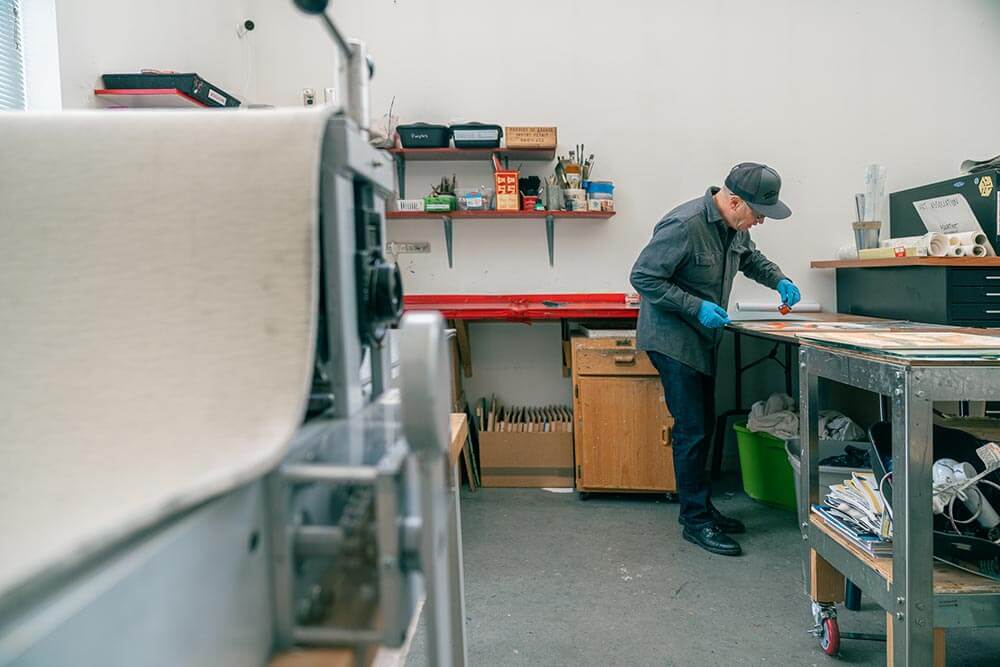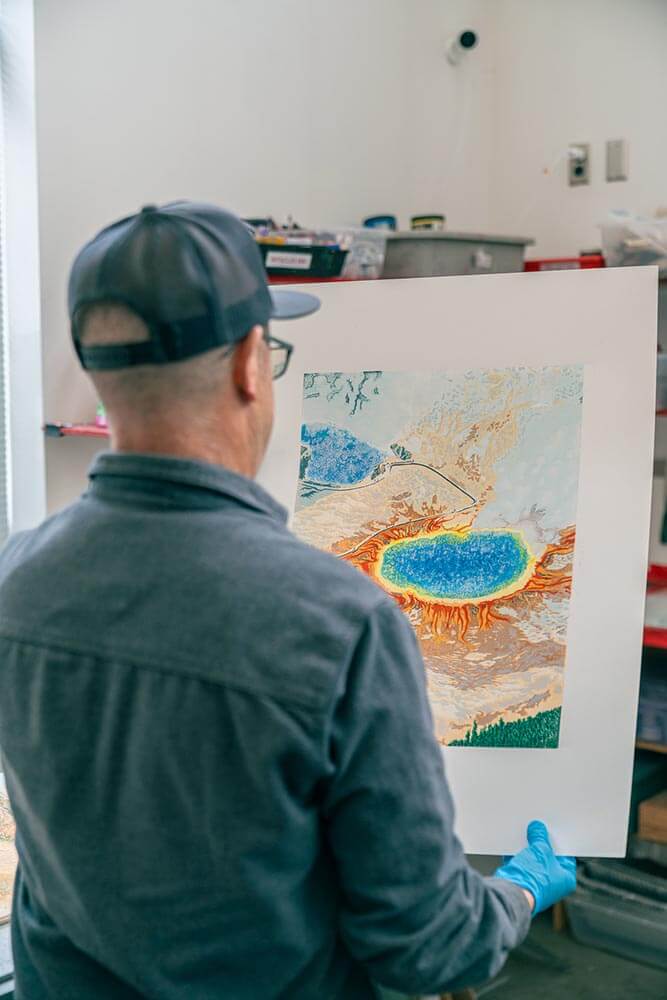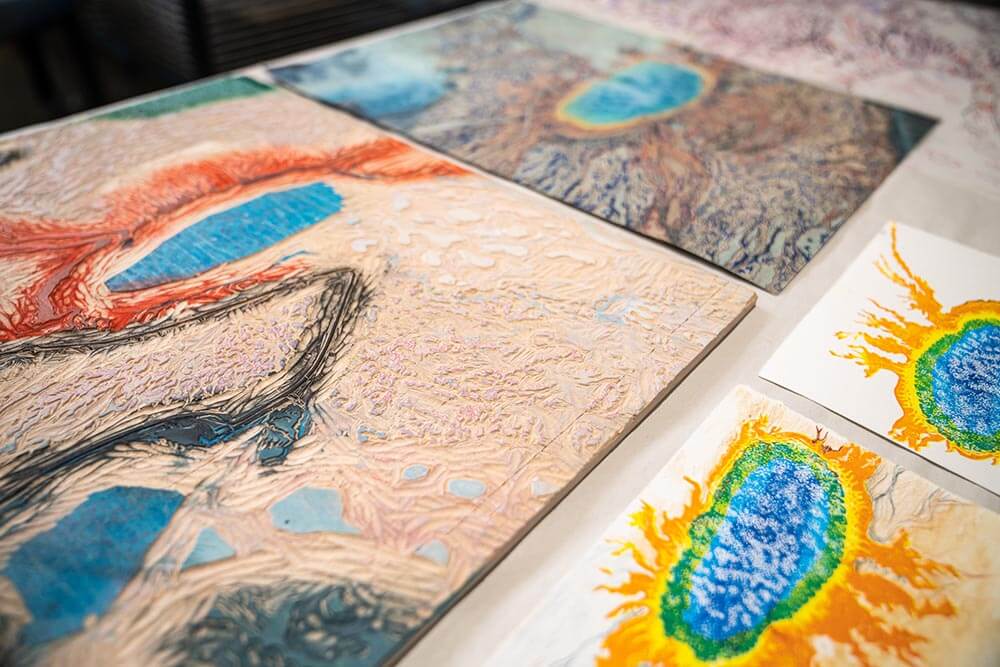Artist Ben Roth finds inspiration in Wyoming’s wild, natural spaces and hopes his work inspires others to protect these areas for generations to come. Recently, Roth worked on a piece to commemorate Yellowstone National Park’s 150th anniversary. Learn more about this Wyoming artist and what inspires his work.
Where in Wyoming do you live and why do you choose to live there?

I live in Jackson, Wyoming. I’ve been here 25 years and I love it. The wilderness around here is abundant and the wildlife seems more prevalent than anywhere I’ve been. And I like the people that live here. This community supports the arts. We have quite a bit of culture for a small town.
What about Jackson speaks to you as an artist?
I love the extreme weather and the seasons. I think the Tetons are amazing. I grew up in Colorado, so I spent a lot of time in the Colorado mountains and the Tetons are just so spectacular. They’re so steep and you can get high up in ’em real quick. I love our big winters. I love going out when there’s two feet of snow out and the gray off season is nice. Summers are a little crazy, but if you get outta town, it’s heaven. It’s an inspiring place. Makes me feel very alive.
What got you into art and did Wyoming inspire that decision at all?
I’ve always made art ever since I was little. I was sculpting things, making things out of paper, elaborate Valentine’s boxes and things like that. But I never thought I could make a living at it. I managed a little bed and breakfast when I first moved to Jackson but immediately started sculpting in clay. I met a local sculptor here, who’s now passed, George Northup. He introduced me to bronze sculpture, so I was dabbling in that. Then when I built a restaurant here in town there was a lot of metal work involved and John Sims taught me how to weld. He’s a local artist and local legend.
I started working with metal and found I really liked it and it came very naturally to me. It almost felt like I’d done it before. But I had a restaurant to run. So I ran the restaurant for a few years, and when I got the opportunity to leave that business, I started doing metal work full time. I figured I was gonna be a furniture designer and I was doing some custom furniture and handrails and things like that. I was making sculptures on the side, and then in 2007 I got involved with the Teton Art Lab. That’s when I was taught how to do printmaking. Since then I do one or two prints a year and this place definitely inspires my work. I really care about the environment. I worry about what’s happening to our climate and the planet and the beauty of Jackson makes me want to protect it. That shows up in my work and it’s the direct result of living here.
What drew you to your medium of artwork?

A few people taught me printmaking techniques through the Teton Art Lab, and I am drawn to that technique. I think printmaking is more like sculpting than painting or drawing. And that’s because of the problem solving and the strategizing that you need to use to create the print. For
instance, when you create the block, you have to produce everything backwards of how you want the final to be, because as you turn it over and print it on the paper, the image is reversed. If you’ve got words on there, they’ve gotta be backwards so that when you go to print them, they
read forward. I like the problem solving.
I chose to be an artist because I like the creative process and I think it’s fun to master something, but there is a tendency to go from creativity to craft. The more materials I can work in, the more my creativity is stimulated and the more tools I add to my bag of tricks. When I come up with an idea, I have more options on how to execute that idea. I like variety. Between wood and steel and bronze and paper and paint, there’s plenty of things to keep me entertained and I can always switch it up when I want. To make a living as an artist, I think you need to be agile.
How does Wyoming inspire you as an artist?
Wyoming is an interesting state. It’s big and windy and cold and doesn’t have a lot of people. I like the sparse population of Wyoming. I like the high desert, and I like the sage and the desert mountain formations in the middle of the state. Then you come out west and you’ve got the forests and the tall mountains and the abundant wildlife. It just seems like land worth protecting. I feel the best thing Wyoming’s got going for it is our natural land, and I want to help protect it and inform people about it. That shows up in my art.
What does Yellowstone National Park mean to you?
I think it was Ken Burns who did the documentary called “America’s Best Idea,” meaning the national parks. And I think he’s right. Protecting these incredible places around us to save for future generations was one of our best ideas. When you go to Yellowstone, you see the historical photos of people going in on primitive vehicles in their Victorian attire. And it’s cool to think that there’s been this long history of people coming out and being inspired by this place. You can imagine the attitude of Native Americans toward Yellowstone as such a spiritual place, and it’s moving. When you’re fishing on the Lamar River and you’re surrounded by bison, it’s incredible. It makes you appreciate the natural world.
Can you tell us more about your Yellowstone 150 piece?

I chose a hard subject, I found, since I made a piece that took 10 rounds of printing to get all the colors and patterns, which was a challenge, but I like a challenge. There’s a reason why they called the Grand Prismatic Pool. You’ve got all these incredible colors and it’s almost like they’re coming out of the earth and bubbling up to the surface. Like we’re getting to see behind the veil. When you look at the land around the spring, it’s like you’re looking back in time. You can see old flows where the water used to run, you see the mineral deposits that have formed. And then you’ve got wildlife walking through, whether it’s elk or bison. And you’ve got this human element that they’ve they’ve created with the addition of boardwalks.
I really am impressed with the way the park has made these formations accessible without humans harming them much. The boardwalks are great. Being able to walk above hot pots and get close to the springs and smell those crazy smells that are coming out of them without harming them… it’s a moving experience. I picked the Grand Prismatic because it’s spectacular. I knew it was gonna be a challenging piece and was hoping it would turn out. I feel like I got it pretty well.
What is your most memorable Yellowstone experience?
I would say fishing the Lamar River with my folks. The Lamar Valley is a big, broad valley in the northern part of the park. It has a lot of bison that are wandering around out in the middle of the valley. Up on the road from above, you look for a spot to get down to the river where you’re not getting too close to the bison. We found a spot where we could get down there and the herds are kind of moving about, but we felt like we were pretty safe. Then I got down on the river and I was fishing a hole and there was a dead tree with a nice hole below it. I was very focused on it. Then I heard someone snoring and I looked over my shoulder and there was this giant bison, like 10 feet from me lying in the sage, sleeping, just snoring away. I just let him sleep and finished fishing. That moment has just always stuck with me. That I could be in such a symbiotic relationship, not disrupting the bison and being part of the environment for a little bit. It was a magical day for my folks and I.
What is a little-known Wyoming place that means a lot to you?
They’re mostly fishing spots, so I can’t tell you where they’re at… When I was a kid, we’d go to Snowy Range. One time we were up there fishing on a lake and a hail storm came in and my dad and a friend of ours and I had to crawl under some bushes to hide from the hail storm. And that was kind of cool old desolate Wyoming, you know, not like the spectacular Western Wyoming. It was kind of a simple, not many people around, not a lot of trees, but still beautiful in the quietude.
Is there anything else you want to say about yourself or your artwork?

Kind of an interesting thing happened in the printmaking process. Like I said, I picked a hard subject matter. The pressure was on, and it was tricky getting the colors right. I really wanted it to pop. On my last round of printing, I decided to come in with a deep burnt orange color over the lighter orange and yellow that I had already printed. And I mixed up what I thought was the right color. I put it on the block. I ran it through the press and it came out pretty red.
While I was working on that piece, I was listening to NPR. The war Ukraine had just begun and the same day, they reported a 75 degree temperature swing in Antarctica. I saw that red around this blue green pool, which looks like the earth to me. I decided not to change the color, but to keep it that strong red to hopefully get people to think about the issues that we’re facing and the changes that we need to make. It seemed poignant and also sort of happened of its own volition. It wasn’t intended, but since it happened, I decided to keep it. And I think it works. I showed it to people and people like the color and it does make the piece pop, but hopefully it’ll make people think too.
During the summer of 2022, you can find Ben Roth’s Yellowstone 150th piece in the form of a free poster at the Jackson Hole & Greater Yellowstone Visitor Center in Jackson. Learn more about his artwork here.